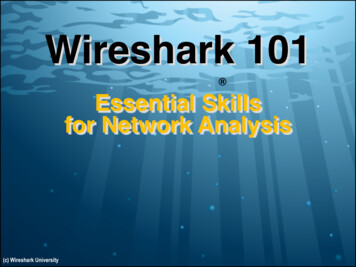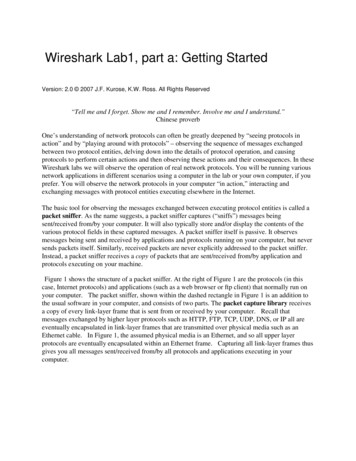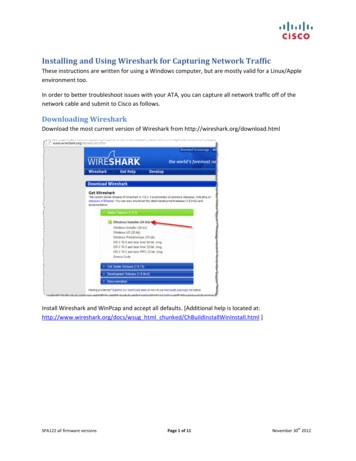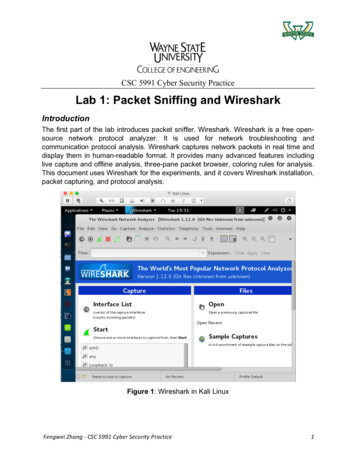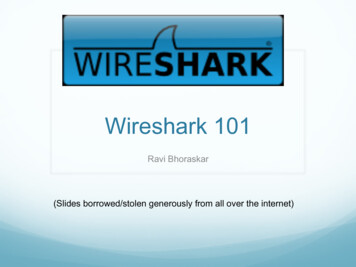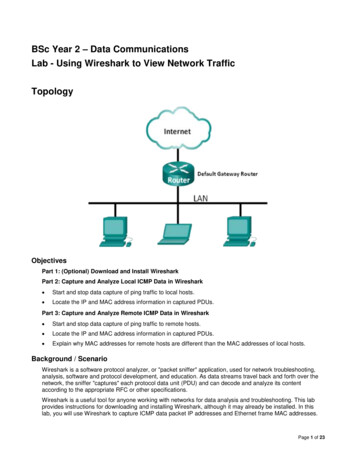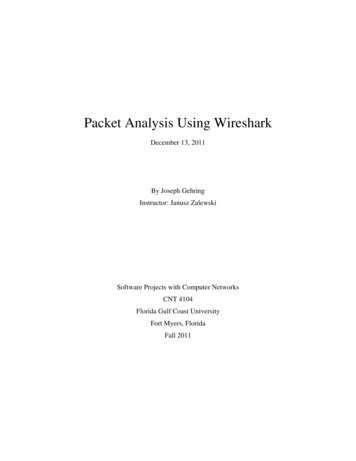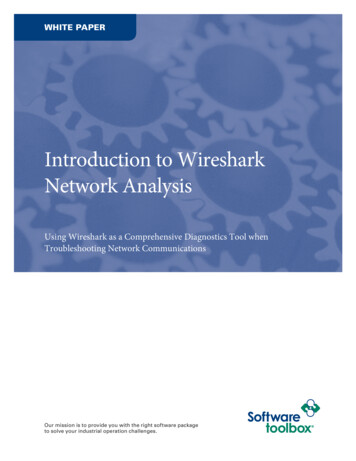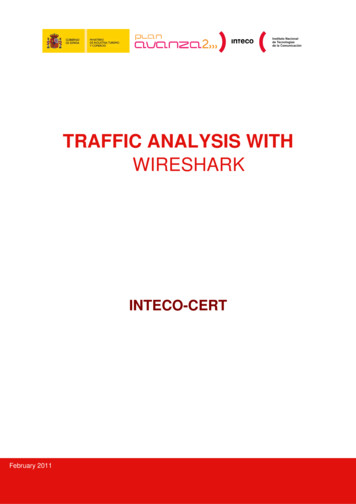
Transcription
SharkFest ’17 EuropeSSL/TLS Decryptionuncovering secretsWednesday November 8th, 2017Peter WuWireshark Core Developerpeter@lekensteyn.nl1
About meIWireshark contributor since 2013, core developer since 2015.IAreas of interest: TLS, Lua, security, . . .IDeveloped a VoIP product based on WebRTC.ICloudflare crypto intern.2
SecretsIThings that people care about: pictures,videos, documents, email conversations,passwords, . . .IApplication Data: cookies, API keys, RequestURI, User Agent, form data, response body, . . .IHow to keep these safe when sending it overthe internet or over your local Wi-Fi network?3
Transport Layer Security (TLS)IIProvides secure communication channel between two endpoints (client and server).Network protocol with two components:IIHandshake Protocol: exchange capabilities, establish trust and establish keys.Record Protocol: carries messages and protects application data TCP TCPIPIP.TLSTCPIP.Server4
Secure Sockets Layer (SSL) versus Transport Layer Security (TLS)ISSLv3: old (RFC 6101, 1996) and deprecated (RFC 7568, 2015). Do not use it!ITLS 1.0 (RFC 2246, 1999), 1.1 (RFC 4346, 2006), 1.2 (RFC 5246, 2008).Changes:IIIINew versions are generally fixing weaknesses due to new attacks.TLS 1.0 (RFC 3546, 2003) and up allow for extensions, like Server Name Indication(SNI) to support virtual hosts.TLS 1.2: new authenticated encryption with additional data (AEAD) mode.I“SSL” term still stuck, e.g. “SSL certificate”, “SSL library” and field names inWireshark (e.g. ssl.record.content type).IMail protocols: TLS often refers to STARTTLS while SSL directly starts with thehandshake.5
“Secure” communication channelISymmetric-key algorithms: encrypt/decrypt bulk (application) data using a single(secret) symmetric key. Examples: AES, 3DES, RC4.IHow to create such a secret? For example, AES-256 needs a 256-bit key.Public-key cryptography: a (secret) private key and a related public key.IIIIIIMathematically hard to compute private key from public key.Encrypt data with public key, decrypt with private key.Limitation: maximum data size for RSA is equal to modulus size, 2048-4096 bits.Idea: generate a random premaster secret and encrypt it with the public RSA key.Where to retrieve this RSA public key from?6
Certificates and trustIPublic key is embedded in a X.509 certificate.IHow can this certificate be trusted?IA Certificate Authority (issuer) signs thecertificate with its private key.Public-key cryptography: use a private (secret)key and a public key with small data.IIIICompress data using a hash function.Examples: SHA256, SHA1, MD5.Sign hash with private key, verify with publickey. Examples: RSA, ECDSA.Root CAs are self-signed and installed by theOS vendor or local admin (Group Policy, etc.).7
TLS handshake with RSA key exchange methodIIClient Hello advertises supported parameters, Server Hello decides.Server picked RSA key exchange: TLS RSA WITH AES 128 CBC SHA. Certificate (with RSA public key) ServerHelloDone8
TLS handshake with RSA key exchange method - ClientKeyExchangeIClient receives Server Hello, knows protocol version and cipher suite.IClient generates a new random 48-byte premaster secret, encrypts it using thepublic key from the Certificate and sends the result to the server in aClientKeyExchange message.IUsing the private RSA key, server (or anyone else!) decrypts the premaster secret.9
TLS handshake with RSA key exchange method - Finishing upIBoth sides calculate the 48-byte mastersecret based on the Client Random,Server Random and the premaster secret.IBoth sides derive symmetric keys from thismaster secret, send the ChangeCipherSpecmessage to start record protection.IFinally they both finish the Handshakeprotocol by sending a Finished Handshakemessage over the encrypted record layer.INow the actual encrypted ApplicationData can be sent and received.10
Handshake overviewClientServerClientHello-------- -------- Application Data ------- ------- loDone[ChangeCipherSpec]FinishedApplication DataSimplified TLS handshake (adapted from RFC 5246 (TLS 1.2))11
Plaintext pleaseIServer administrators can check application logs.IWeb browsers provide developer tools.IWhat if the information is not logged?IWhat if you want to know what this third-party Android app is doing?IWhat if the application under investigation is poorly documented?IWhat if you want to debug your new HTTP/2 feature?ISolution: packet capture plus SSL/TLS secrets!12
Decryption using private RSA server keyConfigure Wireshark with RSA private key file1 :1IIP address is unused and ignored. Port Protocol can be empty. These threefields will be removed in future.ISpecify PEM-encoded key file orPKCS#12 Key File Password.See https://wiki.wireshark.org/SSL#Preference Settings13
Limitations of RSA private keyIIIClients usually do not have access to the RSA key, only server operators can use it.In case of mutual authentication (client certificates), the private key is only usedfor signing. The client private RSA key cannot decrypt.Encrypted premaster secret is not sent with resumed edApplication DataServer-------- --- ------- Application DataMessage flow for an abbreviated handshake (RFC 5246, Figure 2)14
Ephemeral (Elliptic Curve) Diffie-Hellman (ECDHE)IIIIIDecryption using RSA private key not possible with cipher suites likeTLS ECDHE ECDSA WITH AES 128 GCM SHA256 andTLS ECDHE RSA WITH AES 128 GCM SHA256.Although it has RSA in its name, it is not used for encryption, but signing.Instead it uses Diffie-Hellman to establish a shared secret (the premaster secret)based on ephemeral secrets (different secrets for every session).Server chooses a group/curve, generates private value and its related public valueand sends it to the client. Client uses same group/curve and also generates a pair.Computationally hard to find the private value given the public one.15
TLS secrets summaryIAny of these can be used for decryption with passive captures:IIIIIpremaster secret: RSA-encrypted or output from DH key exchangeMaster secret: derived from premaster secret and handshake context. Also used forsession resumption.Symmetric encryption key for record encryption.RSA private key file (for RSA key exchange, covered before).So how to use the master secrets?16
SSL key log fileIText file with master secrets2 .IWorks for any cipher, including RSA and DHE.IClients can use this too!ISet environment variable SSLKEYLOGFILE before starting Firefox or Chrome. Thevariable is only read during startup, so restart if necessary.IFormat: CLIENT RANDOM Client Hello Random master secret .# SSL/TLS secrets log file, generated by NSSCLIENT RANDOM ce4d0d1df63ad8CLIENT RANDOM 3bd5fb19c90061CLIENT RANDOM 989d05c51cc3abCLIENT RANDOM 983ea74f07900eCLIENT RANDOM e417d3d12b3755CLIENT RANDOM d7dc78b711638bCLIENT RANDOM File format at https://developer.mozilla.org/NSS Key Log Format17
Using SSL key log file in WiresharkIConfigure file in Wireshark preferences: Edit Preferences; Protocols SSL;(Pre-)Master Secret log filename.IKey log file is also read during a live capture. And if the file is removed and a newfile is written, the new key log file is automatically read.ICaveat: key log is read while processing ChangeCipherSpec. If key is written toolate, trigger a redissection (e.g. change a preference or (Un)ignore a packet).18
Application and library supportIAny application built using NSS and GnuTLS enable key logging via theSSLKEYLOGFILE environment variable.IApplications using OpenSSL 1.1.1 or BoringSSL d28f59c27bac (2015-11-19) canbe configured to dump keys:v o i d S S L C T X s e t k e y l o g c a l l b a c k ( SSL CTX c t x ,v o i d ( cb ) ( c o n s t SSL s s l , c o n s t c h a r l i n e ) ) ;I3cURL supports many TLS backends, including NSS, GnuTLS and OpenSSL. Keylogging with OpenSSL/BoringSSL is possible with curl 7.56.03Requires a build time option, see https://curl.haxx.se/bug/?i 186619
Key log with OpenSSL 1.1.0 and beforeIWhy: many applications (including Python) use OpenSSL.IProblem: older OpenSSL versions have no key log callback.ISolution: intercept library calls using a debugger or an interposing library(LD PRELOAD) and dump keys4 .IExample with OpenSSL 1.1.0f using an intercepting library5 : export SSLKEYLOGFILE some.keys LD PRELOAD ./libsslkeylog.so curl https://example.com. cat some.keysCLIENT RANDOM 032212FCA24B89 rk-notes/tree/src20
Unsupported applications for SSLKEYLOGFILEIWindows native TLS library is Secure Channel (SChannel). Pending featurerequest for Microsoft Edge browser: 6IExtracting secrets from SChannel is not impossible (but neither easy) though7IApple macOS applications use SecureTransport, also not With-CNG-Soliciting-Secrets-From-SChannel.pdf21
Alternative ways to get the secretIForce RSA key exchange (disable forward-secret cipher suites).ISetup a fake CA and force traffic through a proxy like mitmproxy8 , OWASP Zap,Fiddler or Burp Suite.IAll of these methods can be detected by the client. Certificate pinning can alsodefeat the custom CA method.IThe proxy interception method may also weaken security9 .IIf you are really serious about a passive, nearly undetectable attack from ahypervisor, see the TeLeScope experiment10 gfile.htmlDurumeric et. al., The Security Impact of HTTPS he-depths-of-tls-traffic-in-real-time/922
Feature: Follow SSL StreamIDisplay the contents of thedecrypted application data.IRight-click in the packet list ordetails view, Follow SSL Stream.IGreat for text-based protocols likeSMTP. For binary data, try the HexDump option.IClick on data to jump to relatedpacket (in packet list). Note thatdisplay filter can hide packet, clearthe filter to avoid that.23
Feature: Export HTTP ObjectsIAfter decryption is enabled, HTTPpayloads within TLS (HTTPS) canbe exported.IFile Export Objects HTTP. . .IClick on an item to select it in thepacket list.INote: does not cover HTTP2 orQUIC (yet?) as of Wireshark 2.4.24
Feature: Export SSL Session KeysISuppose you have a capture which is decrypted using a RSA private key file. Howto allow others to decrypt data without handing over your RSA private key file?IFile Export SSL Session Keys. . .IGenerates a key log file which can be used instead of the private RSA key file.INote: currently contains all keys. Remove lines which are not needed (match bythe second field, the Random field from Client Hello).25
Feature: Display FiltersIIIIIIDisplay filters can be used for filtering, columns and coloring rules.Discover by selecting a field in packet list, look in status bar.Recognize TCP/TLS stream in packet list: Right-click TCP Stream Index(tcp.stream) field in packet details, Apply as Column.Right-click field in packet details, Apply/Prepare as Filter.SNI in Client Hello: ssl.handshake.extensions server nameChange in Wireshark 2.4: ssl.handshake.random selects full Client or ServerRandom instead of the just the Random Bytes field. Reason: real time is often nolonger included, full bytes field is useful for matching with key log file.26
Feature: Decode AsIIIForce dissector for custom ports. Decode as SSL (TCP) or DTLS (UDP).Select application data protocol within SSL/TLS layer (since Wireshark 2.4).Example: HTTPS on non-standard TCP server port 4433.IIIIIRight-click TCP layer, Decode As. Change current protocol for TCP Port to SSL.Press OK to apply just for now or Save to persist this port-to-protocol mapping.Right-click SSL layer, Decode As. Change current protocol for SSL Port to HTTP.For STARTTLS protocols, select SMTP/IMAP/. . . instead of SSL for TCP Port.Tip: there are many protocols, just select the field, then use arrow keys or typethe protocol name (typing H gives HTTP).27
Feature: TsharkITshark: command-line tool, useful to extract information as text, especially whenthe query is repeated multiple times.IFind all cipher suites as selected by the server: tshark -r some.pcap-Tfields -e ssl.handshake.ciphersuite -Y ssl.handshake.type 2IList all protocol fields: tshark -G fieldsIConfigure keylogfile:tshark -ossl.keylog file:firefox.keys -r firefox.pcapng.gzIConfigure RSA keyfile (fields correspond to the RSA keys dialog):wireshark -ouat:ssl ark manual: https://www.wireshark.org/28
Future: TLS 1.3IReplaces all previous cipher suites with new one. Dropped all old cipher suites (nomore CBC, RC4, NULL, export ciphers).IRSA key exchange is gone, all ciphers are forward secret.IEncrypted early (0-RTT) data.IEncrypted server extensions (like ALPN)IEncrypted server certificate.IMultiple derived secrets for resumption, handshake encryption, application dataencryption. (Safer resumption!)IDecryption and dissection is supported by Wireshark 2.4 (drafts 18-21 as ofWireshark 2.4.2).29
ConclusionsIRSA private keys cannot be used for decryption in all cases.IThe key log method (SSLKEYLOGFILE) can also be used by clients and works withall cipher suites.ITLS 1.3 debugging is even more difficult without decryption.IUse latest Wireshark version, especially if you are doing any TLS 1.3 work.30
Using SSL key log le in Wireshark I Con gure le in Wireshark preferences: Edit ! Preferences; Protocols ! SSL; (Pre-)Master Secret log lename. I Key log le is also read during a live capture. And if the le is removed and a new
